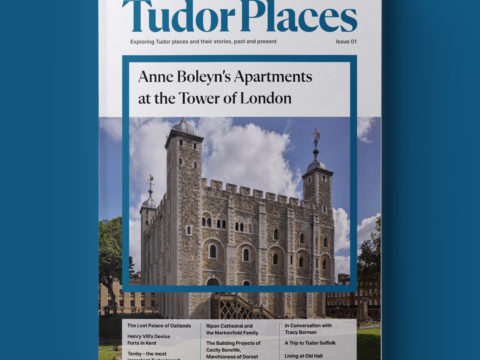John Dudley: Life Story
Chapter 13 : Rivalry
The Imperial Ambassador was convinced that between them, Hertford, Lisle, Paget and Wriothesley would ‘take into their hands the entire direction of affairs…each one will strive his best for his own advancement’. To encourage support, they collectively enabled an extremely generous interpretation of one of the clauses of Henry’s will, relating to ‘unfulfilled’ gifts – that is, gifts Henry was allegedly intending to bestow before he died, which conveniently included land and titles for Hertford and his friends.
In the enormous hand out, Lisle was granted the Earldom of Warwick, whilst Hertford became Duke of Somerset – a formerly royal dukedom. The young King’s sisters were also placated for Somerset’s usurpation of power. Rather than the cash income that Henry had intended, they were given land. The Lady Mary, the King’s heir, received an enormous estate, immediately translating her to the position of one of the greatest landed magnates in the country – a decision that Warwick, as he will now be termed, lived to regret.
Edward was crowned on 20th February 1547. Warwick, along with the newly dubbed Marquis of Northampton (William Parr, brother of Queen Katherine), and Thomas Seymour, now Lord Sudeley, bore the King’s train.
It was not long before Warwick and Somerset were seen to be on less friendly terms than before. Somerset, although a fine general, was rather a dry and humourless man. He had very little flexibility and was disinclined to listen to anyone’s opinion, other than his own. Warwick, described as ‘of high courage’, and popular because of his ‘liberality and splendour’, struggled to accept Somerset as his master.
But there was no open breach. The first rival that Somerset removed was Wriothesley, the Lord Chancellor and newly created Earl of Southampton. He and Somerset had long been at loggerheads, and by early March, he was indicted – the charge included speaking ’unfitting words’ to Somerset – an indication that the Duke was taking his position very seriously. He soon reorganised the Council, and persuaded it to grant him quasi-royal powers. In his new-found arrogance, he addressed the King of France as ‘brother’, only to receive a rebuke from the offended monarch.
Somerset was not satisfied with the religious changes of Henry’s reign, and sought to implement a more radical reformation – moving from the reformed Catholicism of Henry, to a definitely Protestant stance. Images that had been ‘abused’ were ordered to be removed and the Chantries were supressed on the grounds that prayers for the dead were pointless and irreligious. This unleashed a wave of iconoclasm and many of the old relics, church ornamentation, and even stained glass, were destroyed, whilst radical preachers, who would have risked being burnt under Henry, appeared in many pulpits.
During the summer of 1547, Warwick acquiesced in all of Somerset’s actions, although the Protector’s brother was not so obedient. He courted trouble by courting the Queen Dowager, whom he secretly married, having persuaded the young King to think it was his own idea. Relations between the brothers deteriorated, exacerbated by the Duchess of Somerset’s insolence to the Queen.
Meanwhile, the peace in France looked fragile. Francois had only out-lived his old sparring partner, Henry, by a couple of months. The new king, Henri II, was determined to regain Boulogne, and also to promote the Franco-Scottish alliance. He was an affectionate friend to the Queen Dowager of Scotland, Marie of Guise, and eager to promote the marriage of her daughter, Mary, Queen of Scots, to his son, the Dauphin, rather than to King Edward.
Somerset determined to crush Scotland for ever. He sent orders to Warwick, now Governor General of the North, to muster an army and marched to join him in the usual burning and pillaging of the Borders. The aggression culminated in the Battle of Pinkie, in which Warwick held high command. The English achieved a notable victory, following which Warwick marched on Edinburgh, supported by the English navy in the Firth of Forth.
However, Somerset was soon aware that England did not have the money or manpower permanently to subjugate its northern neighbour and the Protector hurried back to London, where his brother had been making mischief in his absence, by developing a relationship with the King – this was necessarily conducted at second hand and largely consisted of Seymour sending Edward cash.
Seymour also came up with the idea of taking as his ward, the young King’s cousin, Lady Jane Grey (great-granddaughter of Henry VII). His plan was to encourage a match between the cousins at a later date. He spent most of 1548 planning how to extend his power, as his wife, Queen Katherine, prepared to have her first child.
Katherine died in childbed, and perhaps his grief overcame such sense as Seymour had. He became completely uncontrollable in his attempts to wrest power from his brother and in the spring of 1549, he was arrested. The French ambassador reported that Warwick had encouraged Somerset to take drastic measures and other writers claimed that Warwick had, if not created the quarrel between the brothers, certainly fomented it. In March 1549, Seymour’s death warrant was signed by his brother and he was executed. This act, although it seemed necessary to Somerset at the time, was looked on with horror and surprise. Even the hardened men of the Tudor court were uncomfortable with fratricide.
Sir John Dudley
Family Tree




